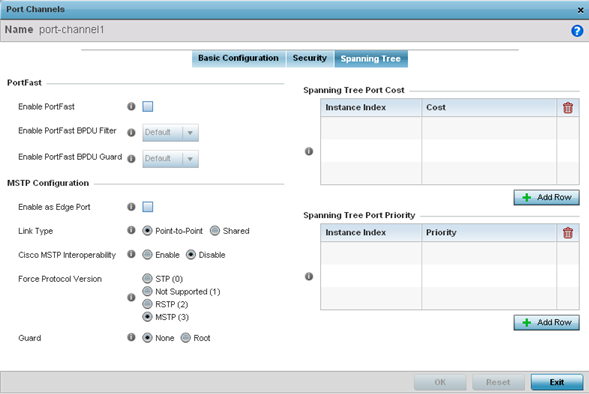Port Channel Spanning Tree
To define a port channel' spanning tree configuration:
-
Select the Spanning Tree tab.

-
Define the following PortFast parameters for the port channel's MSTP configuration:
Enable PortFast Select the check box to enable drop-down menus for both the port Enable Portfast BPDU Filter and Enable Portfast BPDU guard options. This setting is disabled by default.
PortFast BPDU Filter Select Enable to invoke a BPDU filter for this portfast enabled port channel. Enabling the BPDU filter feature ensures this port channel does not transmit or receive any BPDUs. The default setting is None.
PortFast BPDU Guard Select Enable to invoke a BPDU guard for this portfast enabled port channel. Enabling the BPDU Guard feature means this port will shutdown on receiving a BPDU. Thus, no BPDUs are processed. The default setting is None.
-
Set the following MSTP Configuration parameters for the port channel:
Enable as Edge Port Select the check box to define this port as an edge port. Using an edge (private) port, you can isolate devices to prevent connectivity over this port channel. This setting is disabled by default.
Link Type Select either the Point-to-Point or Shared radio button. Selecting Point-to-Point indicates the port should be treated as connected to a point-to-point link. Selecting Shared indicates this port should be treated as having a shared connection. A port connected to a hub is on a shared link, while the one connected to the wireless device is a point-to-point link. Point-to-Point is the default setting.
Cisco MSTP Interoperability Select either the Enable or Disable radio buttons. This enables interoperability with Cisco's version of MSTP, which is incompatible with standard MSTP. This setting is disabled by default.
Force Protocol Version Sets the protocol version to either STP(0), Not Supported(1), RSTP(2) or MSTP(3). MSTP is the default setting.
Guard Determines whether the port channel enforces root bridge placement. Setting the guard to Root ensures the port is a designated port. Typically, each guard root port is a designated port, unless two or more ports (within the root bridge) are connected together. If the bridge receives superior (BPDUs) on a guard root-enabled port, the guard root moves the port to a root-inconsistent STP state. This state is equivalent to a listening state. No data is forwarded across the port. Thus, the guard root enforces the root bridge position.
-
Refer to the Spanning Tree Port Cost table. Select + AddRow as needed to include additional indexes.
Define an Instance Index using the spinner control and then set the Cost. The default path cost depends on the user defined port speed. The cost helps determine the role of the port channel in the MSTP network. The designated cost is the cost for a packet to travel from this port to the root in the MSTP configuration. The slower the media, the higher the cost.
Speed
Default Path Cost
<=100000 bits/sec
200000000
<=1000000 bits/sec
20000000
<=10000000 bits/sec
2000000
<=100000000 bits/sec
200000
<=1000000000 bits/sec
20000
<=10000000000 bits/sec
2000
<=100000000000 bits/sec
200
<=1000000000000 bits/sec
20
>1000000000000 bits/sec
2
-
Refer to the Spanning Tree Port Priority table. Select + Add Row needed to include additional indexes.
Define an Instance Index using the spinner control and then set the Priority. The lower the priority, a greater likelihood of the port becoming a designated port.
-
Select OK to save the changes made to the Ethernet Port Spanning Tree configuration. Select Reset to revert to the last saved configuration.



